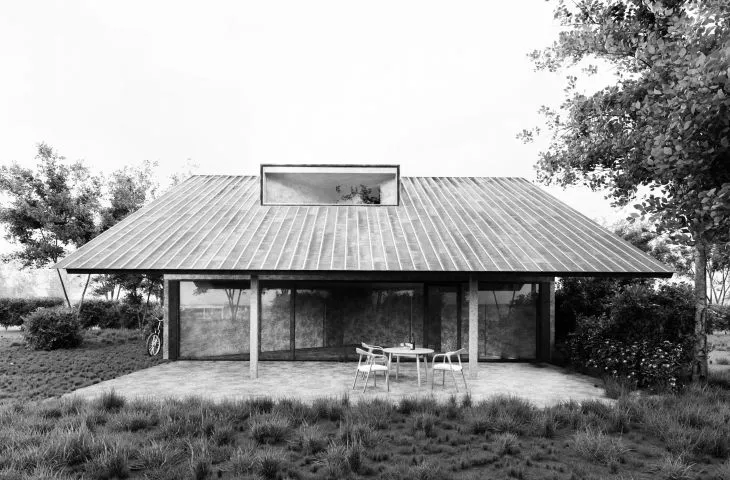The {tag:pracownie} created a design for a single-family house that could be built anywhere in the world due to its universal idea and form. Designer Mateusz Załuska, inspired by historical examples, decided to bring back the theme of niche in architecture.
The design of the house is a response to an unusual program - the building was to include a separate space for contemplation, where one can stay in solitude and silence. It was clear to the architect that he had to find a formula that responded to the contrast between the two extremes contained in the program. He had to subordinate to one structure and logic - the most garden-exposed common space and the smallest one - the private and quiet one. Inspired by examples of historical architecture, the author decided to evoke the theme of the niche.
The house is characterized by a roof extending beyond the outline of the building
© Studio Załuska
As Mateusz Załuska explains:
The niche is an element of architectural articulation appearing in the history of most civilizations. Beginning with the most famous niches for statues in ancient architecture, through Gothic portals, Renaissance palaces, and Middle Eastern prayer niches, they appeared wherever one wanted to distinguish something , to expose it, or when one tried to contain in an architectural frame a space much larger than what could be built. When a niche becomes a room in which one resides, one has the impression of being fully open to the surroundings. On the other hand, it gives a sense of protection, of being able to withdraw into its depths. These interesting qualities make it still a valid topic for exploration.
First floor with a large terrace and a private area on the first floor
© Studio Załuska
space-building niches
The use of a large nic he on the first floor and garden level created a living room - the most public space. The second niche, with the same geometry but smaller in size, was designed as a room at the very end of the building. Placed higher than the bedroom level, it became the most isolated and intimate room in the house. The space is open in the same direction as the living room, but thanks to the higher ceiling it has gained a wider view of the landscape and sky. This treatment promotes tranquility, reading and contemplation. The two niches are the core of the entire design. All other rooms are arranged around them, and the distribution of functions and the use of masonry partitions allow for free combinations and possible changes in the future.
The living room is open to a shaded terrace, and there is a meditation room on the first floor
© Studio Zaluska
On the first floor, to the right of the entrance is a guest room, and opposite is the living room with an opening to the terrace. The first floor is occupied by three bedrooms and a bath room, dressing room and toilet. The rooms on this level at the highest punkce are 360 cm, which allows for good convection and keeping a low temperature close to the floor on the hottest days. From the central space of the hall, illuminated by a small slope window, you can reach the contemplation room.
cross-section and elevation of the house
© Studio Załuska
dark roof and light concrete
The roof slopes extend well beyond the building's outline, creating a parking shed, a canopy for the entrance and a terrace. They effectively shade the glazed areas, protecting the interiors from overheating, and create additional covered spaces usable on warm days.
The house was designed with monolithic light-colored concrete
© Studio Załuska
The house, with 144 square meters of living space, was designed with monolithic light-colored concrete. The material was accentuated in the interiors - all floors are oiled concrete screed. Secondary partition walls were planned from hollow block painted light gray. The roof is a wooden truss of dark stained beams, covered with standing seam metal. The facade is covered with mineral light gray plaster, maintaining the continuity of wall color between the interior and exterior.














































